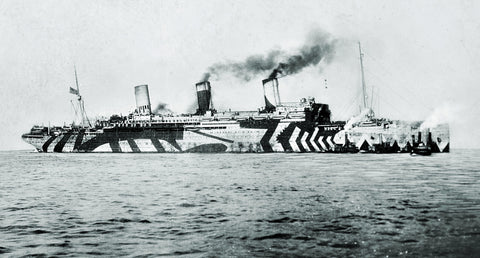
Now You See Me, Now You Don’t
The USS Leviathan, photographed here in 1918, was a U.S. troop transport during the First World War. Most warships of the period were painted gray, to stand out less against the sea and clouds, especially with the constant threat of German U-Boat attack. Leviathan’s wild design, on the other hand, stands out like a sore thumb. Bizarrely, though, this pattern was thought to be the more effective camouflage.
The Royal Navy had been trialing various forms of naval camouflage throughout the war. A young Winston Churchill himself was keenly interested in natural patterns like the zebra or tiger. In nature, “disruptive camouflage” may not be as effective at hiding against a background, but it can confuse or “dazzle” the observer while in motion, making it harder to estimate the size, shape, speed, or direction of the camouflaged animal at a glance.
Artist Norman Wilkinson used similar justifications when presenting his “dazzle camouflage” concept to the British government in 1917. By Wilkinson’s logic, enormous ships were impossible to hide, with their billowing smoke. Instead, the focus should be on making them harder to hit. With semi-random contrasting patterns at odd angles, a U-Boat should have a harder time judging a ship’s heading and speed, making torpedoes less accurate.
The idea caught on with both the Royal Navy and, later, the U.S. Navy. Results, however, were mixed. When the data came back after the war, “dazzle ships” were fired on slightly more often than those with standard gray paint. On the flip side, those dazzle ships that were hit sank slightly less often.
While dazzle would largely disappear after the First World War, ship camouflage continued to evolve. Ships in WWII and beyond would adopt subtler contrasting shades of grey, reminiscent of the ubiquitous green military camo patterns. Examples of disruptive camouflage would emerge sporadically, but none as unique as dazzle.
historynet magazines
Our 9 best-selling history titles feature in-depth storytelling and iconic imagery to engage and inform on the people, the wars, and the events that shaped America and the world.
